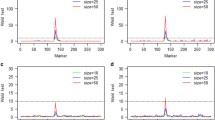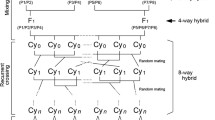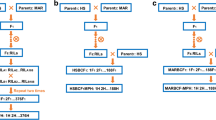Abstract
Along with the development and integration of molecular genetics and quantitative genetics, many quantitative trait locus (QTL) mapping studies have been conducted using different mapping populations in various crop species. Existing QTLs can be used for marker-assisted breeding and map-based cloning, whereas the false-positive QTLs are no use. The purpose of this study is to evaluate the suitability of different mapping procedures for data from different genetic models. In this study, four types of recombinant inbred lines (RILs) with different genetic models, viz. additive QTLs (Model I), additive and epistatic QTLs (Model II), additive QTLs and QTL × environment interaction (Model III), additive, epistatic QTLs and QTL × environment interaction (Model IV), were simulated by computer. Six types of QTL mapping procedures, viz. CIM, MIMF, MIMR, ICIM, MQM and NWIM, on four kinds of QTL mapping software, viz. WinQTL Cartographer Version 2.5, IciMapping Version 2.0, MapQTL Version 5.0 and QTLnetwork Version 2.0, were used for screening QTLs of the simulated RILs. The results showed that different mapping procedures have different suitability for different genetic models. CIM and MQM can only screen Model I data. MIMR, MIMF and ICIM can only screen Model I and Model II data. NWIM can screen all four models’ data. It can be concluded that different genetic models’ data have different most suitable mapping procedures. In practical experiments where the genetic model of the data is unknown, a multiple model mapping strategy should be used, that is a full model scanning with complex model procedure followed by verification with other procedures corresponding to the scanning results.
Similar content being viewed by others
References
Basten CJ, Weir BS, Zeng ZB (1994) Zmap-a QTL cartographer. In: Smith C, Gavora JS, Benkel B, Chesnais J, Fairfull W, Gibson JP, Kennedy BW, Burnside EB (eds) Proceedings of the 5th World Congress on genetics applied to livestock production: computing strategies and software, vol 22. The Organizing Committee, 5th World Congress on genetics applied to livestock production, Guelph, ON, Canada, pp 65–66
He XH, Xu CW, Kuai JM, Gu SL, Li T (2001) Principal factors affecting the power of detection and accuracy of QTL mapping. Acta Agron Sin 27(4):469–475
Kao CH, Zeng ZB, Teasdale RD (1999) Multiple interval mapping for quantitative trait loci. Genetics 152:1203–1216
Lander ES, Bostein DR (1989) Mapping Mendelian factors underlying quantitative traits using RFLP linkage map. Genetics 121:185–189
Li H, Ye G, Wang J (2007) A modified algorithm for the improvement of composite interval mapping. Genetics 175:361–374
Lu YY, Liu BH (1995) A new computer package for genomic research: PGRI (plant genome research initiative). In: Abstract of plant genome III conference, San Diego, CA. http://www.intl-pag.org/3/abstracts/201pg3.html
Manly KF, Cudmore JR, Meer JM (2001) Map Manager QTX, cross-platform software for genetic mapping. Mamm Genome 12:930–932
Nelson JC (1997) QGENE: software for marker-based genomic analysis and breeding. Mol Breed 3:239–245
Su CF, Lu WG, Zhao TJ, Gai JY (2010) Verification and fine-mapping of QTLs conferring days to flowering in soybean using residual heterozygous lines. Chin Sci Bull 55(6):499–508
Utz HF, Melchinger AE (1996) PLABQTL: a program for composite interval mapping of QTL. J Agric Genomics 2:1–5
Van Ooijen JW, Kyazma BV (2004) MapQTL 5, software for the mapping of quantitative trait loci in experimental populations. Wageningen, The Netherlands
Van Ooijen JW, Maliepaard C (1996) MapQTL version 3.0: software for the calculation of QTL positions on genetic maps. In: Abstract of plant genome IV conference, San Diego, CA. http://www.intl-pag.org/4/abst-racts/p316.html
Wang JK (2009) Inclusive composite interval mapping of quantitative trait genes. Acta Agron Sin 35(2):239–245
Wang DL, Zhu J, Li ZK, Paterson AH (2003) User manual for QTLMapper version 1.6-A computer software for mapping quantitative trait loci (QTLs) with main effects, epistatic effects and QTL × environment interactions. Department of Agronomy, Zhejiang University, Hangzhou, China. http://ibi.zju.edu.cn/software/qtlmapper/
Wang S, Basten CJ, Zeng ZB (2007) Windows QTL cartographer 2.5. Department of Statistics, North Carolina State University, Raleigh, NC. http://statgen.ncsu.edu/qtlcart/WQTLCart.htm
Yang J, Zhu J, Williams RW (2007) Mapping the genetic architecture of complex traits in experimental populations. Bioinformatics 23:1527–1536
Yang J, Hu CC, Hu H, Yu RD, Xia Z, Ye XZ, Zhu J (2008) QTLNetwork: mapping and visualizing genetic architecture of complex traits in experimental populations. Bioinformatics 24:721–723
Acknowledgments
This work was supported by The National High Technology Research and Development Program of China (863 Program) (Grant No. 2006AA10Z1D2) and Transgenic Modified Organisms Breeding Major Projects of Ministry of Agriculture (2011ZX08005-005).
Author information
Authors and Affiliations
Corresponding author
Rights and permissions
About this article
Cite this article
Su, C., Qiu, X. & Ji, Z. Study of strategies for selecting quantitative trait locus mapping procedures by computer simulation. Mol Breeding 31, 947–956 (2013). https://doi.org/10.1007/s11032-013-9848-6
Received:
Accepted:
Published:
Issue Date:
DOI: https://doi.org/10.1007/s11032-013-9848-6




